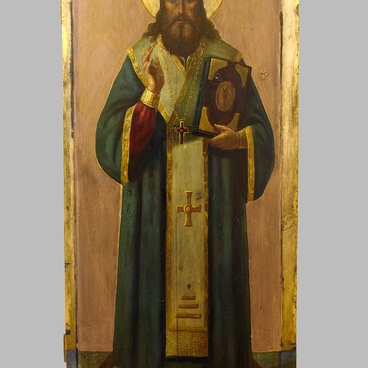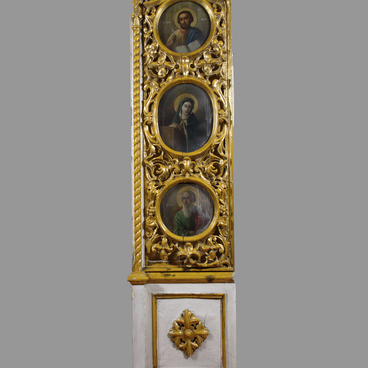The icon of the Resurrection is an image created to constantly remind Christians of Christ’s great sacrifice. The Resurrection of Christ is of key importance in the Christian faith, it gives believers the hope of salvation and eternal life. Without faith in the Holy Resurrection, Christianity loses its basic meaning.
The scene of the Resurrection has traditionally been one of the most complex for iconographers. This is largely due to the fact that the event itself had no real witnesses and all ideas about it were taken from written sources containing some information about the appearance of Christ to the women and his disciples.
The Resurrection scene is historically represented in several different versions. However, almost all of them feature characteristic elements, including the icon presented in the exhibition, which decorated the church in the name of the icon of the Mother of God “Joy of All Who Sorrow” in Michurinsk from the 1940s until the early 21st century.
In Christian iconography, the image of the most supernatural and most important moment of the Gospel narrative — the scene of Christ’s Resurrection — is almost nowhere to be found, as this event remains beyond the reach of human perception. The iconographic theme of the Resurrection of Christ, presented through the prism of the “descent into Hell”, is the most widespread iconographic subject. Interestingly, every known icons of the “Holy Resurrection” is distinguished by the large number of characters. Along with the central figure of the Savior Himself, numerous images are depicted that are closely related to the Resurrection of Christ and the events that followed. Some icons feature the first men, Adam and Eve, because Christ was able to save all people by His death on the cross. Other images include the broken Gates of Hell trampled on by Christ, which symbolizes His victory over the devil. Sometimes icons depict angels at the feet of Christ emerging from the tomb, or the terrified guards and pious myrrh-bearers. The icon from the Michurinsk Museum shows Archangel Gabriel and Roman soldiers-guards.
The scene of the Resurrection has traditionally been one of the most complex for iconographers. This is largely due to the fact that the event itself had no real witnesses and all ideas about it were taken from written sources containing some information about the appearance of Christ to the women and his disciples.
The Resurrection scene is historically represented in several different versions. However, almost all of them feature characteristic elements, including the icon presented in the exhibition, which decorated the church in the name of the icon of the Mother of God “Joy of All Who Sorrow” in Michurinsk from the 1940s until the early 21st century.
In Christian iconography, the image of the most supernatural and most important moment of the Gospel narrative — the scene of Christ’s Resurrection — is almost nowhere to be found, as this event remains beyond the reach of human perception. The iconographic theme of the Resurrection of Christ, presented through the prism of the “descent into Hell”, is the most widespread iconographic subject. Interestingly, every known icons of the “Holy Resurrection” is distinguished by the large number of characters. Along with the central figure of the Savior Himself, numerous images are depicted that are closely related to the Resurrection of Christ and the events that followed. Some icons feature the first men, Adam and Eve, because Christ was able to save all people by His death on the cross. Other images include the broken Gates of Hell trampled on by Christ, which symbolizes His victory over the devil. Sometimes icons depict angels at the feet of Christ emerging from the tomb, or the terrified guards and pious myrrh-bearers. The icon from the Michurinsk Museum shows Archangel Gabriel and Roman soldiers-guards.

